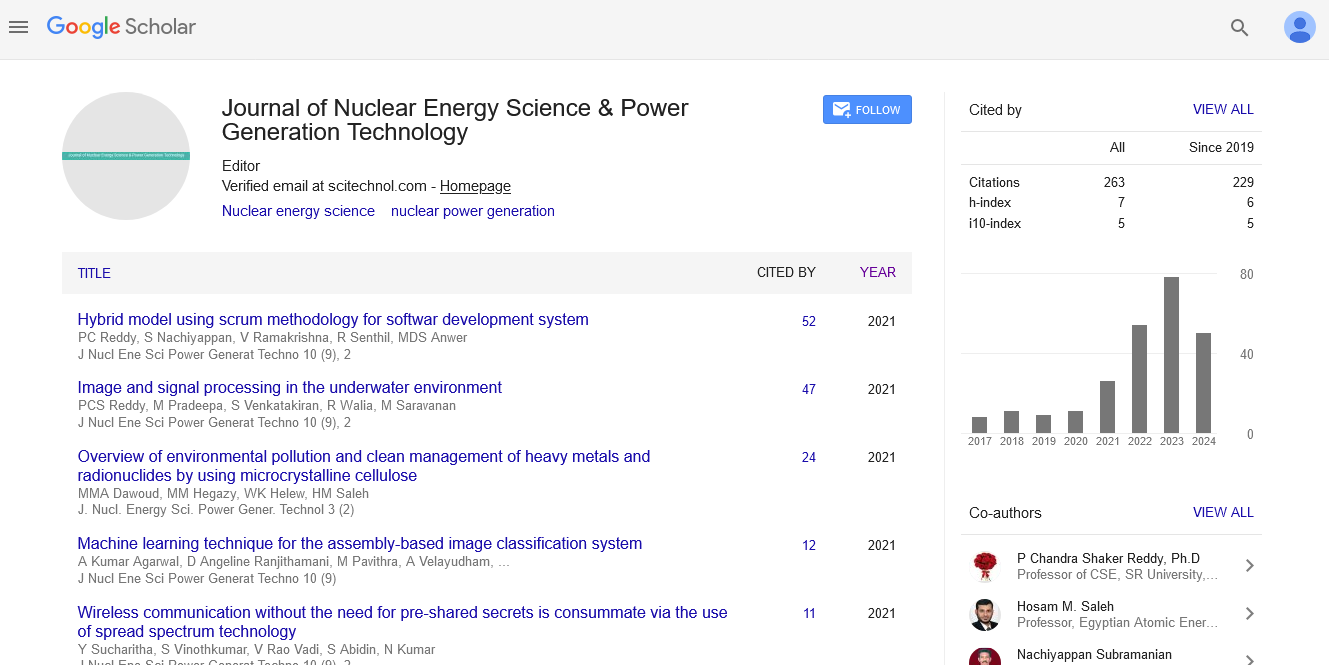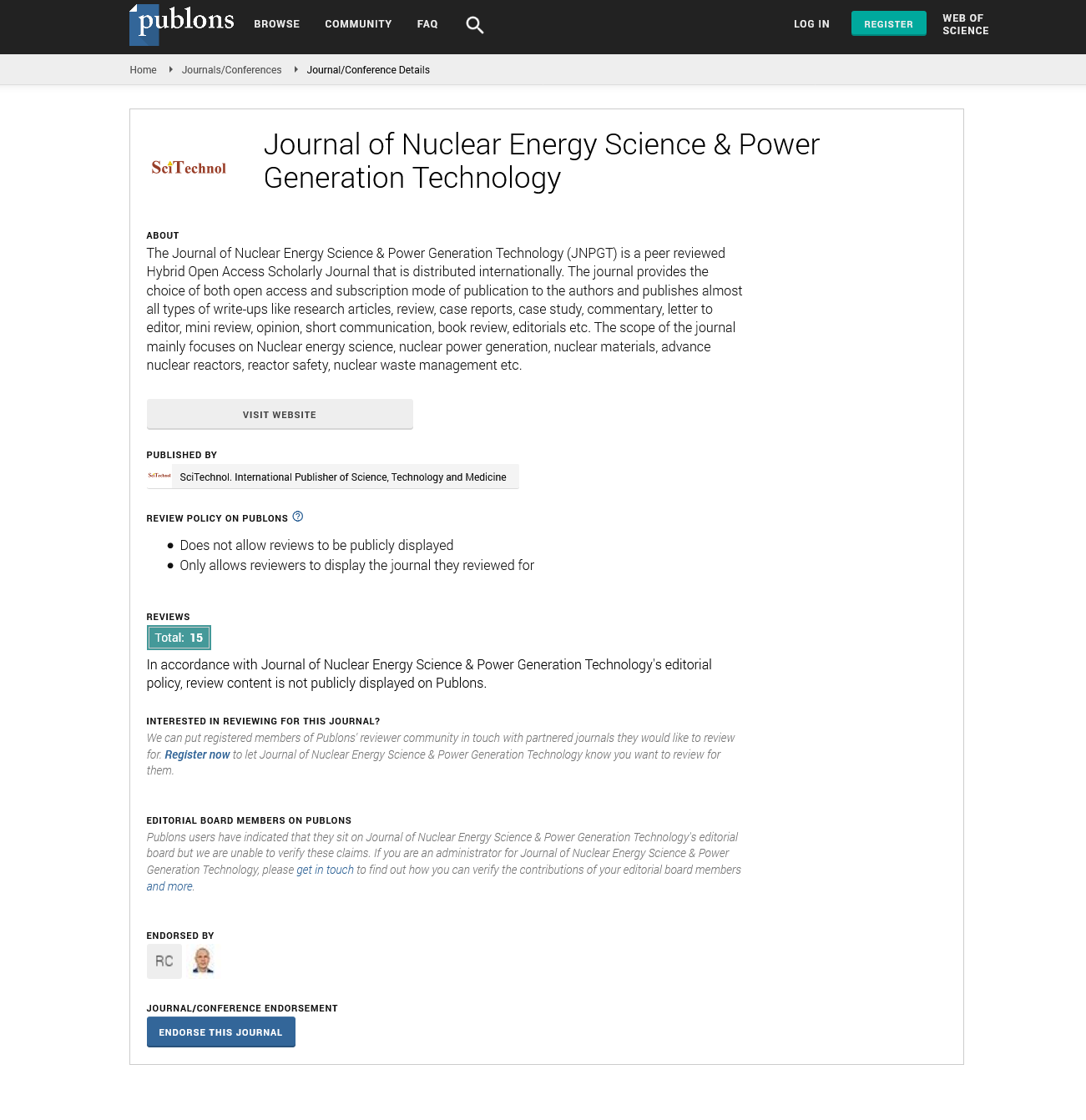Opinion Article, J Nucl Ene Sci Power Generat Technol Vol: 13 Issue: 6
Bioenergy from Waste: A Sustainable Pathway for Clean Energy
John Doe*
1Department of Nuclear and Radiological Engineering, Georgia Institute of Technology, Atlanta, USA
*Corresponding Author: John Doe,
Department of Nuclear and Radiological
Engineering, Georgia Institute of Technology, Atlanta, USA
E-mail: johndoe22@gmail.com
Received date: 21 October, 2024, Manuscript No. JNPGT-24-154880;
Editor assigned date: 23 October, 2024, PreQC No. JNPGT-24-154880 (PQ);
Reviewed date: 06 November, 2024, QC No. JNPGT-24-154880;
Revised date: 13 November, 2024, Manuscript No. JNPGT-24-154880 (R);
Published date: 21 November, 2024, DOI: 10.4172/2325-9809.1000431.
Citation: Doe J (2024) Bioenergy from Waste: A Sustainable Pathway for Clean Energy. J Nucl Ene Sci Power Generat Technol 13:6.
Description
Transition toward more sustainable energy sources, bioenergy derived from waste presents an increasingly attractive option. With a growing global population and urbanization, waste generation is at an all-time high, producing both a challenge and an opportunity. Instead of letting waste pile up in landfills or incinerators it can be converted into bioenergy providing a renewable energy source that reduces greenhouse gas emissions, helps manage waste and promotes energy security. Bioenergy from waste refers to the process of converting organic materials, such as agricultural residues, food waste, sewage sludge and municipal solid waste into usable energy forms like biogas, bioethanol and biodiesel. This process typically involves biological conversion such as anaerobic digestion or fermentation, or thermal conversion methods like gasification or pyrolysis.
The most common method of generating bioenergy from waste is anaerobic digestion, where microorganisms break down organic materials in the absence of oxygen to produce biogas, primarily methane. This biogas can be used for electricity generation or as a substitute for natural gas in heating applications. Another process, gasification involves heating organic materials at high temperatures to produce syngas which can then be used to generate electricity or converted into fuels. One of the primary benefits of bioenergy from waste is its role in waste management. In many parts of the world, landfills have become the default method of handling waste, which can lead to harmful environmental impacts. As waste decomposes in landfills, it produces methane a potent greenhouse gas. However, by converting waste into bioenergy, methane emissions can be captured and used as a clean fuel, thus reducing the environmental impact of waste disposal.
Moreover, the conversion of waste into bioenergy reduces the volume of waste that needs to be landfilled or incinerated. This not only helps alleviate pressure on landfill space but also reduces the air pollution associated with waste incineration. Waste-to-energy technologies are, therefore, vital in managing the growing amounts of waste generated by urban populations and reducing the environmental burden of traditional waste management practices. Bioenergy from waste provides significant environmental and economic advantages. By utilizing organic waste, this technology reduces the dependence on fossil fuels, helping to moderate the effects of climate change. It also provides an opportunity to generate energy locally, reducing the need for costly energy imports and improving energy security. Furthermore, bioenergy production from waste helps decrease the overall carbon footprint of waste disposal processes.
The economic benefits are equally compelling. The development of bioenergy from waste technologies can help jobs in waste management, energy production and technology development sectors. By generating biofuels and biogas, waste-to-energy plants can provide a renewable source of energy that is both sustainable and economically viable. The use of waste as a feedstock also helps lower production costs for biofuels compared to using traditional crops like corn or sugarcane. First, the efficiency of conversion technologies must be improved to make bioenergy production more costcompetitive with other energy sources. The collecting, transporting and preprocessing waste materials can also be complicated, requiring significant infrastructure investments.
Conclusion
Bioenergy from waste represents a powerful tool in the search of a sustainable, circular economy. By turning waste into valuable energy, not only reduce environmental harm but also produce a renewable energy source that can help change global energy needs. As technology advances and policy frameworks evolve, the widespread adoption of waste-to-energy solutions has the potential to transform the way we manage waste and produce energy, providing a win-win scenario for both the environment and the economy. Another challenge is the variability in the quality and composition of waste materials, which can affect the efficiency of conversion processes. Additionally, public perception and regulatory hurdles can slow the adoption of waste-to-energy technologies. For example, concerns over air and water pollution from waste-to-energy plants, particularly in terms of toxic emissions and residual ash, need to be carefully managed and regulated.
 Spanish
Spanish  Chinese
Chinese  Russian
Russian  German
German  French
French  Japanese
Japanese  Portuguese
Portuguese  Hindi
Hindi 

